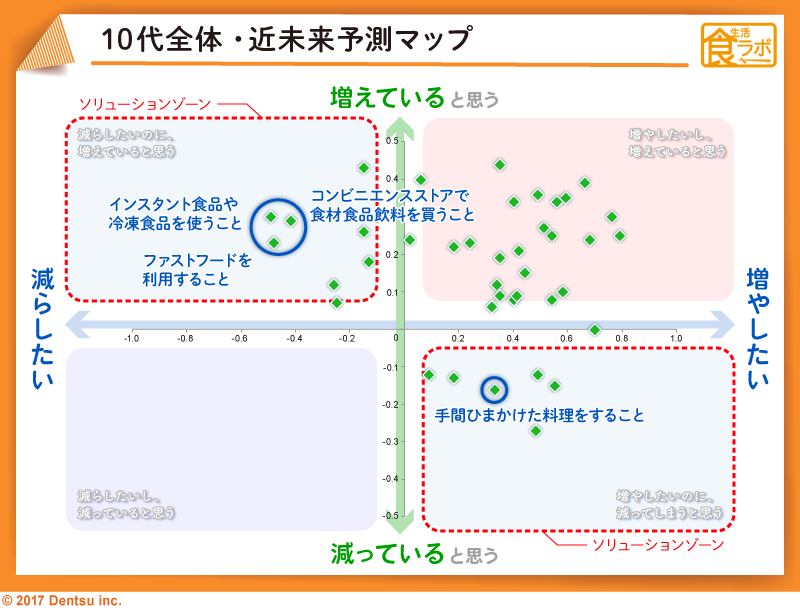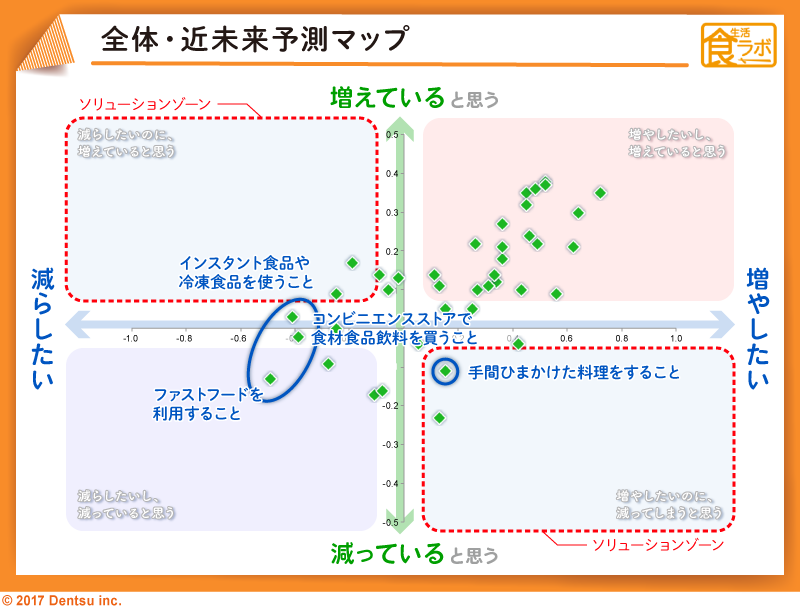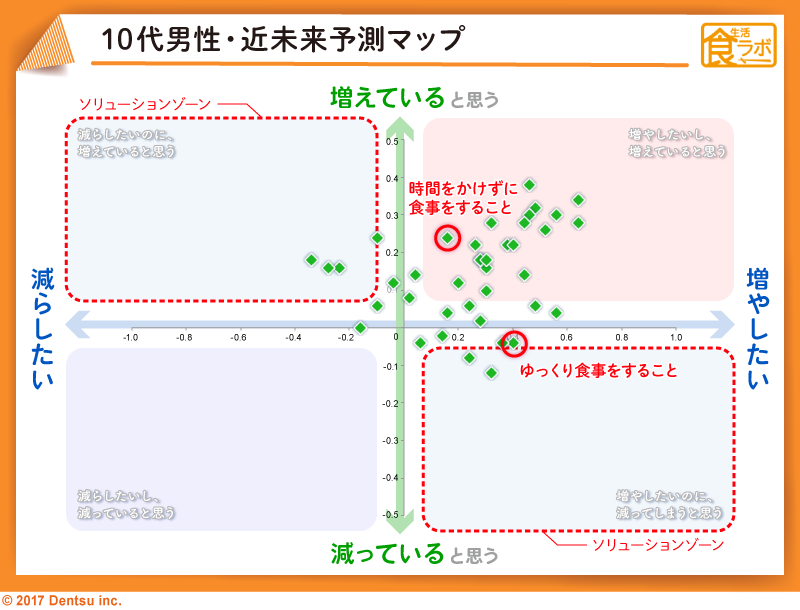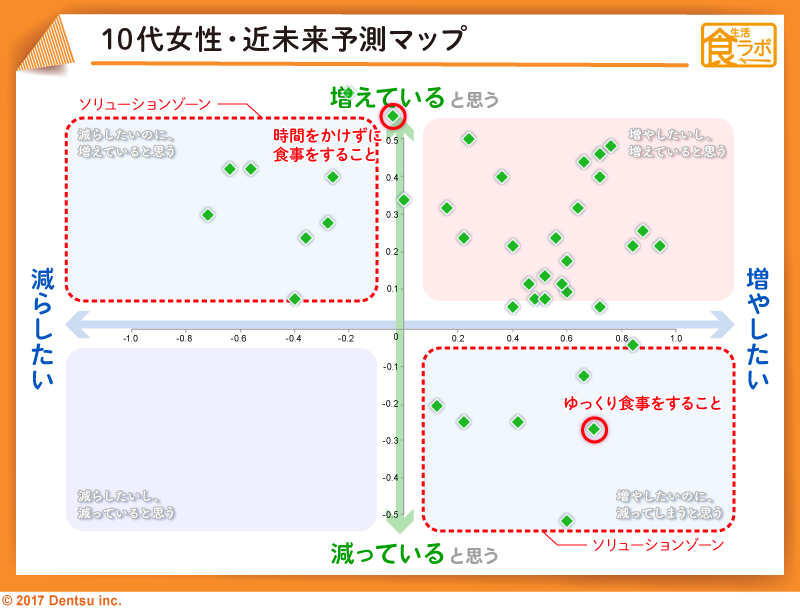Nice to meet you.
I'm Chie Haruhara, in charge of the second installment of the Dentsu Inc. Food Lab series.
This time, we focus on "young people's food," specifically "teenagers' food."
These young people will become members of society in five or ten years, form families, and become key players in food. By understanding the characteristics of their food-related values and behaviors, and the social background behind them, we might even glimpse the challenges facing Japan's food sector and the future of food itself. That's the idea behind this project.
To uncover the near-future food landscape envisioned by consumers, Dentsu Inc. conducted the "Near-Future Mind Survey"*.
This survey presented 40 food-related items and asked respondents to imagine their eating habits in 3-4 years, indicating whether each item would "likely increase/decrease" or if they "wanted to increase/decrease" it. The results were scored, and the average values for each item were mapped to create the "Near Future Prediction Map."
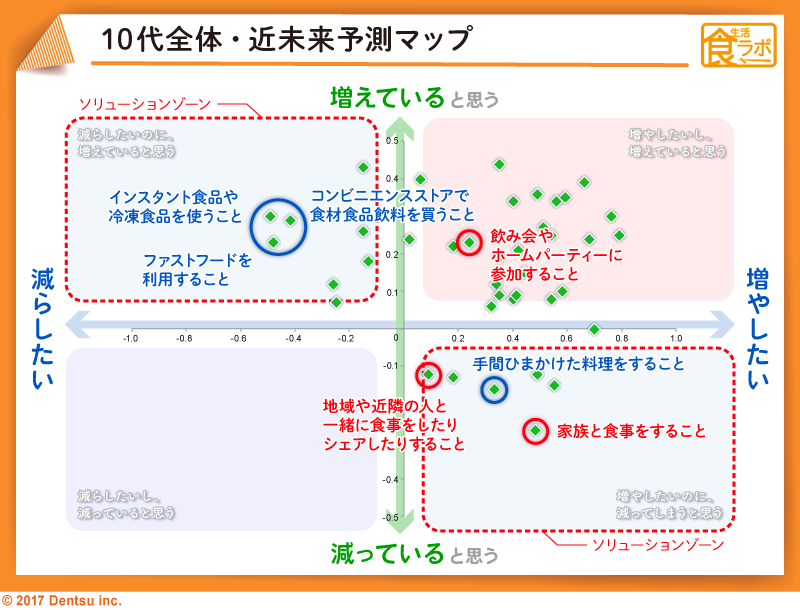
(15-19 year old males and females)
On the Near Future Prediction Map, the upper left and lower right zones plot items that are "wanted to decrease but seem likely to increase" and "wanted to increase but seem likely to decrease," respectively. These zones represent a gap between ideal and reality, forming the "Solution Zone" where solutions are needed.
This Near-Future Prediction Map for teens revealed their desire to eat "proper meals" and "together with others." We'll also interpret this against the backdrop of the SNS culture that's part of their daily lives.
For teens, it's about proper meals over quick fixes.
We compared the near-future prediction maps for teens with those for all age groups.
First, focusing on the distribution of items, the near-future prediction map for teens shows more items in the Solution Zone than other age groups, and these items are positioned at higher scores.
This indicates teens have a strong awareness of food-related challenges.
Looking at the items plotted in the Solution Zone: In the upper-left "Want to reduce but likely to increase" zone, items related to easy and convenient food appear, such as "instant and frozen foods," "convenience stores," and "fast food."
In the bottom-right "Want to increase but likely to decrease" zone, "Cooking time-consuming meals" was plotted.
This suggests teens have a mindset of "taking food seriously."
Next, we compared male and female teens.
Female teens tended to plot items higher in the solution zone scores compared to male teens, showing a stronger tendency to avoid convenient, ready-to-eat foods and lean toward time-consuming cooking.
Furthermore, gender differences were even more pronounced regarding time spent on meals.
For teenage boys, "eating slowly" was positioned toward the middle of the solution zone. "Eating quickly" did not fall within the solution zone at all.
However, for teenage girls, both "eating slowly" and "eating without spending much time" appear in the high-score zone of the solution area.
These results indicate that teens (especially females) strongly desire to engage with food proactively, investing time and effort beyond mere nutrition intake, yet they find it difficult to achieve this.
"Delicious" is best shared with someone.
Another notable feature is the high scores in the "Want to reduce but likely to increase" zone for "Eating alone" and in the "Want to increase but likely to decrease" zone for "Eating with family."
Compared to other age groups, teens particularly value "eating with family," yet their circumstances often make this difficult. Considering today's children are busy with cram schools and extracurriculars, and that parents of teens are in their late 30s to 40s—prime working years—this result makes sense.
While trends like "one soup, one dish" and "meal prep" have gained popularity recently, shortening and streamlining meal preparation time is a beneficial solution not only for moms and dads but also for their children.
Furthermore, beyond the previously mentioned "family meals," it was found that parents want to increase "real-life social interactions" such as "attending drinking parties or home parties" and "eating with people in the community or neighborhood."
This characteristic was observed only among teenagers.
In other words, teens show a strong desire to enjoy food with others.
Food is the ultimate Instagram-worthy experience
When discussing teens, social media platforms like Instagram are essential.
When we think of "Instagram-worthy," the image that comes to mind is teenage girls taking selfies together in front of photogenic sweets, seeking that perfect shot.
So why is food so often chosen as content to post on Instagram? I believe one reason is that food is content that combines universality and uniqueness.
First, eating is a basic action everyone performs three times a day, possessing a universality that anyone can understand. Therefore, food photos are easy to post, and viewers can easily give them a "like," making them suitable content.
Yet, they also allow people to clearly express their personal values and lifestyle. For instance, a colorful parfait embodies cuteness, while a carefully prepared homemade meal showcases a thoughtful approach to daily life. Additionally, posting about a weekend cafe date with a boyfriend or a BBQ with club friends simply conveys the message that you are valued by your peers. This aspect allows individuals to express their unique identity.
Rather than wolfing down convenience store meals or instant food alone, they want to be seen enjoying proper meals or favorite foods with someone. And they want everyone to know and acknowledge that version of themselves.
This desire for "Instagram-worthy" moments seems to reflect the attitudes toward food revealed among teenagers this time.
Food, being so closely tied to people's lives, truly reflects the times.
After the postwar era when eating was the ultimate luxury, instant foods became widespread.
Then came the period of high economic growth, when people were told to work hard, even skimping on time for meals.
Then came the bubble era, where food became a status symbol and a competition for extravagance. As a reaction, the recession era emerged, focused on cost-performance, pursuing health and beauty with everyday ingredients.
And now, young people, especially teenagers, may view food as content, using it to present themselves on social media.
In recent years, drinks providing complete nutrition in a single cup have been developed, making it increasingly unnecessary to deliberately spend time and effort on food.
Yet food continues to be cherished as a vital time and central to communication among teens, albeit in new forms.
As long as teens keep turning their attention to food, Japan's culinary future looks bright. That's what Food Lab believes.
Next time: "Food and Solitude."
It might seem like a sudden shift to a darker topic, but by unraveling the feelings behind eating alone, we might uncover the challenges facing Japan's food culture as single-person households rapidly increase. Stay tuned!
(Note: Regarding the Near Future Mind Survey)
An internet survey conducted in September 2016, presenting 40 food-related items to 1,200 individual respondents nationwide (ages 15-79, both men and women).


